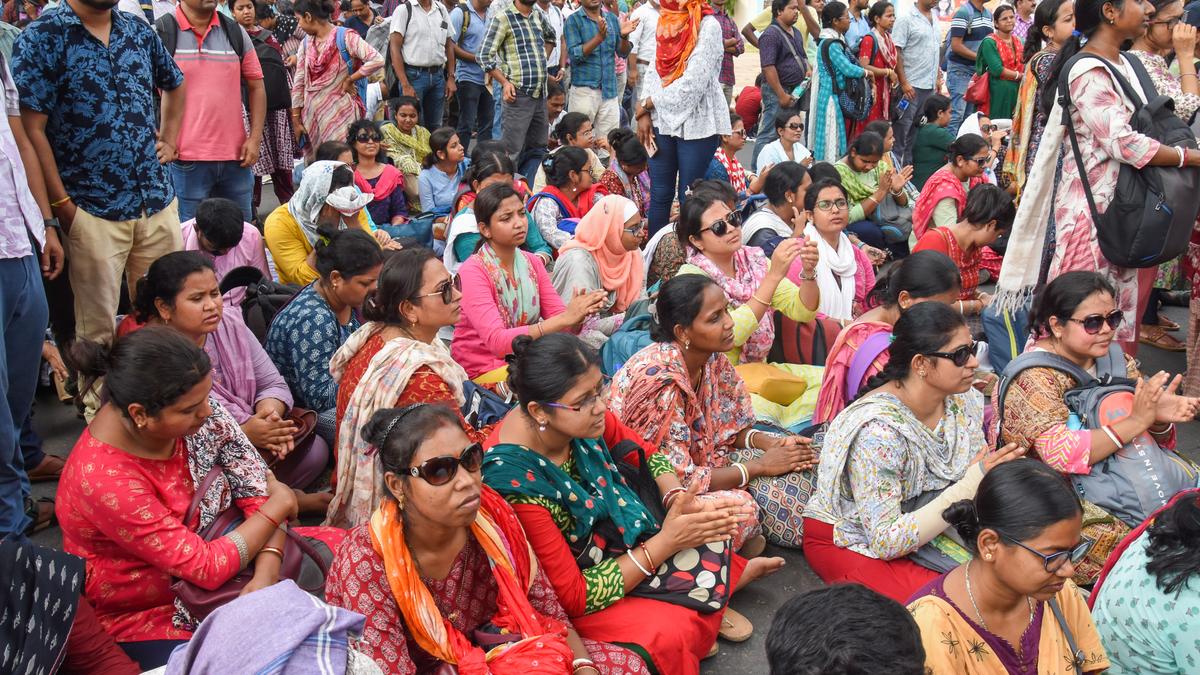
Teachers who lost their job following a Court verdict, stage a sit-in protest outside School Service Commission (SSC) office, demanding their jobs back, in Kolkata on April 21.
| Photo Credit: ANI
The story so far:
Last week, after days of protests outside the headquarters of the West Bengal School Service Commission (WBSSC) in Kolkata’s Salt Lake area, hundreds of teachers of State-run schools decided to call off the agitation for a week. The protests had erupted on April 21 after the State government went back on its promise to make public the list of ‘tainted’ and ‘untainted’ candidates in the recruitment process carried out in 2016.
What did the government say?
The government said it had sent the list of ‘tainted’ and ‘untainted’ candidates to the district inspectors of schools. The protesters said they would return to their schools, and resume the protest in a few days. On April 26, another group of protesting employees, the non-teaching staff of State-run schools, held a meeting with the State government. Chief Minister Mamata Banerjee announced that as long as the matter is pending before the courts, the State government would hand out ₹25,000 per month for Group C staff and ₹20,000 per month for Group D staff.
What have the courts ruled?
These developments followed a Supreme Court order on April 3 which upheld a Calcutta High Court decision of April 22, 2024 cancelling en bloc appointments of 25,752 teaching and non-teaching staff in State-run schools. The recruitment process was carried out in 2016 by the WBSSC. A Bench consisting of Chief Justice of India Sanjiv Khanna and Justice Sanjay Kumar agreed with the High Court’s finding that the selection process was “vitiated and riddled with manipulations and fraud.”
The Supreme Court and the Calcutta High Court ordered the termination of an entire panel of teaching and non-teaching staff as neither the WBSSC nor the West Bengal government came up with a list of ‘tainted’ and ‘untainted’ candidates before the court. The loss of appointments of about 25,000 teaching and non-teaching staff across 19,000 schools raised serious questions on the functioning of schools in the State.
What relief has been granted?
On April 17, the Supreme Court granted some relief to the West Bengal government by allowing the services of ‘untainted’ teachers to the State’s government and aided schools to be retained till a fresh recruitment process is completed by the end of 2025. The Court, however, passed no such order for non-teaching staff.
After the April 17 order, pressure mounted on the State government and the WBSSC to release the list of ‘tainted’ and ‘untainted’ candidates. The State government, however, insisted that teachers would get their salaries. “You don’t need to worry about who is tainted and who is not. You only need to worry about whether you have your job and whether you are getting your salaries on time,” Ms. Banerjee said at a public meeting on April 22. So far, neither the West Bengal Education Department nor the WBSSC has officially come out with the list. However, the protesting teachers who held meetings with WBSSC have pointed out that out of 17,206 teachers recruited during 2016, 15,403 were ‘untainted’ and eligible to continue teaching till the end of 2025.
As the West Bengal school recruitment scam continues to make headlines, the big question is around the list and the number of ‘tainted’ and ‘untainted’ recruitments. The protesting employees say it is not just about salaries but also about dignity, and that it is necessary to separate the grain from the chaff.
When did the scam surface?
The school recruitment scam came to the fore with the arrest of former State School Education Minister Partha Chatterjee by the Enforcement Directorate in July 2022. Subsequently, several arrests were made in the scam which involved cash-for-school jobs recruitment.
Published – April 30, 2025 08:30 am IST
Anurag Dhole is a seasoned journalist and content writer with a passion for delivering timely, accurate, and engaging stories. With over 8 years of experience in digital media, she covers a wide range of topics—from breaking news and politics to business insights and cultural trends. Jane's writing style blends clarity with depth, aiming to inform and inspire readers in a fast-paced media landscape. When she’s not chasing stories, she’s likely reading investigative features or exploring local cafés for her next writing spot.




